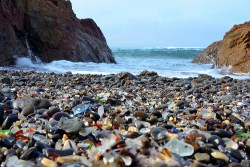
Photo by John Krzesinski.
I am looking out at a gorgeous kelp-filled cove on the Northern California coast. Waves crash on jagged rocks, quarrelsome seabirds swoop and dive over the foam, and the tidepools around me teem with anemones, crabs, and tiny, tiny fish. This place appears as wild and pristine as any spot on the American seashore.
Until I look down at my feet. Because I am standing on an engine block.
At least I think that’s what it is. Some sort of geared mechanism is clearly visible inside a larger, rusty outline. But the whole thing is barely distinguishable from the surrounding rocks. It’s as though it’s being digested by the earth.
This is what is now known as Glass Beach in Mendocino County’s Fort Bragg. Until 1967, this land, owned by a lumber company, was referred to as “the Dumps.” Here, local citizens tossed the crap they were done using, including cars, appliances, and apparently a lot of empty bottles. Sometimes they lit the piles of refuse on fire.
Eventually the good people of Fort Bragg decided that the cove might be better off as something other than an enormous trash can, and they closed the area to dumping. Over the next few years, it was gradually cleaned up, and eventually the private land was transferred to the state and became part of a public park.
Today, it’s popular with people who (against regulations, as this is now considered an archeological site) collect the sea glass that permeates every inch of the sand. Two other glass beaches can be found nearby. On this, the most accessible beach, the pieces are mostly quite small, perhaps because they’ve been so thoroughly picked over. But they are everywhere, glittering white and green and brown and blue in the pebbly sand.
Person after person comes down to the shoreline, picks up a handful of sand, starts sifting though … and then just sits down in place, fixated on the multitude of glistening, rounded fragments, hundreds of pieces in any random sample, thousands within a few inches. You can’t stop looking. What treasure might surface in the next handful? Plenty of people load their pockets with the glass. It’s like a reverse dump, now.
Sea glass is one form of human detritus that doesn’t seem like an abomination when it gets mixed back into the environment. Even in the stark wild beauty of Mendocino County — or Hanapepe, Hawaii, or many other locations around the world where you can find other glass beaches — the evidence of human waste is not disturbing so much as it is fascinating.
But glass isn’t all the human junk you can find on this beach. It’s just the most obvious remnant of our carelessness. The remains of larger discards, like that engine block, have been essentially swallowed up by the rock as the waves have done their work in some process that remains mysterious to me. I found one large area where dozens of spark plugs jutted out from the craggy formations. You couldn’t pick up these bits of plastic and wire. They had, over the years, been embedded into the natural geology of the place.
Later in the day, the friend who took me to the beach said that being there made her feel hopeful about the future of Earth. If that one little place could turn from a flaming garbage dump into a gorgeous natural refuge in less than 50 years, maybe it meant that everything was going to be all right with the planet, right? Right?
Sure, I’d like to think so. Look in the right places, and you can feel optimistic. Former garbage dumps around the country and the world are being returned to nature, like Brookfield and Freshkills on New York’s Staten Island. From Israel to Australia, people are cleaning up and replanting where there used to be nothing but trash.
But while old garbage dumps are getting cleaned up, new ones are appearing, and not all are above the surface. In places like Indonesia, natural wonders like the Bunaken Island National Park are being inundated with garbage right now. In that remote location, garbage disposal methods are essentially what they were in Mendocino County in the mid-20th century. Refuse is dumped by the side of the road and washes out to sea in the rainy season, ending up as litter on some of the most beautiful coral reefs in the world.
The more I thought about it, the more the glass beach at Fort Bragg seemed like a bad reason to feel hopeful. There are only about 7,000 people living in the town; it is relatively easy to get rid of the cast-offs from so few. But even they are still producing waste that goes somewhere. Not into a beautiful rocky cove, but somewhere.
We can fool ourselves into thinking that the planet can digest our garbage, or our carbon. We can look at a place like Glass Beach and tell ourselves how pretty the shiny bits of human debris are when the waves wash over them.
Or we can look closer, and see the evidence of our own destructive nature, right under our feet. And try to do better.



